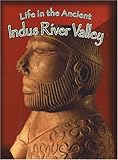- ISBN13: 9780778720706
- Condition: NEW
- Notes: Brand New from Publisher. No Remainder Mark.
Product Description
Ages 8 to 14 years. The Indus River Valley was once home to thriving communities of peoples who worked the land now known as Pakistan. Some of the world’s oldest civilisations, including the Harappans and the Maurya and Gupta empires, grew in this fertile region. This beautiful new book beautifully documents the lives of these remarkable people from long ago. Topics include: farming innovations that helped support larger populations; the arrival of Hinduism and Buddhism; daily life in a Harappan village; the development of the caste system; early language and writing; the arrival of the White Huns.
Buy This book from Amazon Now! Shipping in Pakistan & Round the world available Click Life In The Ancient Indus River Valley to buy now.


Don’t let the cover of this book fool you. The lovely cover makes this book look like a high school or college text, but upon opening it you will find it appeals to a younger crowd. Their are lovely pictures and illustrations. The text is succinct and relatively easy to read. There are many pictures to keep the reader engaged. If your upper elementary to middle school age child finds ancient history a little boring, give this book a try. It is fact-filled but well-illustrated and to-the-point. A great addition to your library if you homeschool; great to flesh out your history lesson if you use MOH or TOG.
Rating: 4 / 5
I read this book with my 9-year old son, and he liked it quite a bit. He loves reading and learning about India, and this was a great introduction to Ancient Indian history. The book explains complex ideas like reincarnation, karma, nirvana etc quite accurately in simple words. My son understood those concepts in the first reading!
The book talks about Harappan and Aryan civilizations, almost concurrently, and on one ocassion he got confused between them.
Rating: 4 / 5
This is a social history of life in ancient India targeted at late elementary schoolers.
It is organized into 14 two-page, thematic spreads that follow a general chronological progression (from the Harrappan civilizations through the Aryan conquest, Mauryan Age, and and the rise of Buddhism) but have a way-of-life emphasis. The packaging, full of drawings, artifacts, and photographs of people and places, is very well done, and the text is clear.
The only drawback is that the presentation is rather dry and textbook-like. However, it is still a very good introduction to an area that is rarely covered by books of this level.
Rating: 4 / 5